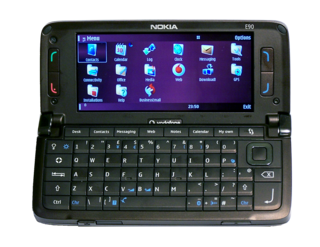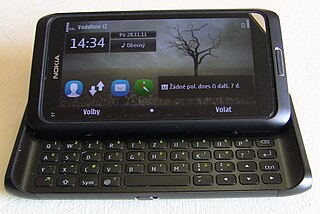Gallery
- Nokia 9000 Communicator (right)
Nokia 9110 Communicator (left) - Nokia 9110 Communicator
- Nokia 9210 Communicator
- Nokia 9500 Communicator
- Nokia E90 Communicator
- Nokia 9210i, 9500 and E90 Communicators
The Nokia Communicator is a brand name for a series of business-optimized mobile phones marketed by Nokia Corporation, all of which appear as normal (if large) phones on the outside, and open in clamshell format to access a QWERTY keyboard and an LCD screen nearly the size of the device footprint.
Nokia Communicators have Internet connectivity and clients for Internet and non-Internet communication services. The earlier 9000 series Communicators introduced features which later developed into smartphones. The latest Communicator model, the Nokia E90 Communicator, is part of the Nokia Eseries.
| Model | Nokia 9000 Communicator, 9000i | Nokia 9110 Communicator, 9110i | Nokia 9210 Communicator, 9210i, 9290 | Nokia 9500 Communicator | Nokia E90 Communicator | |
|---|---|---|---|---|---|---|
| Released | 1996 | 1998 | 2001 | 2004 | 2007 | |
| Operating system | PEN/GEOS 3.0 | Symbian OS version 6.0, Series 80 v1.0 | Symbian OS version 7.0s, Series 80 v2.0 | Symbian OS version 9.2, S60 3rd Edition | ||
| Processor | Model | Intel 80386EX | AMD Élan SC450 Am486 | ARM920T | Ti OMAP 1510 | Ti OMAP 2420 |
| clock speed | 24 MHz | 33 MHz | 52 MHz | 150 MHz | 332 MHz | |
| Memory | RAM (accessible) | 4 MB (4×220 bytes) | 4 MB | 8 MB | 64 MB (39.6 MB) | 128 MB (110 MB) |
| ROM (accessible) | 4 MB (2 MB) | 4 MB (2 MB) | 16 MB (2 MB) | 128 MB (79.8 MB) | 256 MB (136 MB) | |
| Screen | Internal | 4.5 in (110 mm) 640×200 monochrome STN, 4 grayscales | 4.5 in (110 mm) 640×200 backlit monochrome STN, 8 grayscales | 4.5 in (110 mm) 640×200 color transflective TFT, 4,096 scales | 4.5 in (110 mm) 640×200 color transflective TFT, 4,096 scales | 3.9 in (99 mm) 800×352 color transflective TFT, 16,777,216 scales |
| External | 50×38 backlit monochrome STN, 2 grayscales | 1.3 in (33 mm) 80×48 backlit monochrome STN, 2 grayscales | 1.3 in (33 mm) 84×48 backlit monochrome STN, 2 grayscales | 1.3 in (33 mm) 84×48 backlit monochrome STN, 2 grayscales | 2 in (51 mm) 240×320 color transflective TFT, 16,777,216 scales | |
| Weight | 397 g (14.0 oz) [1] [2] | 253 g (8.9 oz) [3] [4] | 222 g (7.8 oz) [5] | 222 g (7.8 oz) [6] | 210 g (7.4 oz) [7] | |
The Nokia 9300 [8] and 9300i [9] (running Symbian OS version 7.0s and Series 80 v2.0) are very similar to the Nokia 9500 but were not marketed under the Communicator name by Nokia. Likewise, the Nokia N97 and Nokia E7 (running Symbian^3) from 2009 and 2011 respectively are also similar to the Communicator series, but not marketed as it.

Nokia 9500 Communicator is a mobile phone produced by Nokia, introduced on 24 February 2004 and released in November 2004. It runs on the Symbian-based Series 80 platform.
Open Programming Language (OPL) is a programming language for embedded systems and mobile devices that run the operating systems EPOC and Symbian. It was released by the British company Psion in 1984.

The Nokia 9210 Communicator is a third-generation Communicator series mobile phone produced by Nokia, announced on 21 November 2000 and released in June 2001. It greatly improved on the second generation Nokia 9110 Communicator, providing a colour main screen and using an ARM processor. It is one of the few mobile phones able to send and receive fax.

The Nokia 9000 Communicator was the first product in Nokia's Communicator series, announced at CeBIT 1996 and introduced into the market on 15 August 1996. The phone weighed 397 grams (14.0 oz), was powered by an Intel 24 MHz i386 CPU, and had 8 MB of memory. The memory was divided between applications (4 MB), program memory (2 MB) and user data (2 MB). The operating system was PEN/GEOS 3.0. The Communicator was one of the earliest smartphones on the market, after the IBM Simon in 1994 and the HP OmniGo 700LX, a DOS-based palmtop PC with integrated cradle for the Nokia 2110 cellular mobile phone, announced in late 1995 and shipped in March 1996.

The Nokia 9300 is a Nokia Series 80 Symbian mobile phone introduced in 2004. It is used as a normal though bulky mobile phone in closed mode, when it is flipped open it can be used like a very small notebook computer with a 640×200 screen. The phone also has speakerphone functionality, which is activated automatically when the phone is flipped open. An MP3 player is also built into the phone. It didn't have vibration motor due to its shape.

The Series 90 is a platform for mobile phones that use Symbian OS. It was developed by Nokia in collaboration with Psion. It was released in 2003 and was going to be the platform for the Nokia 7700 which was cancelled, but did eventually make it to market with the Nokia 7710.
Nokia's Series 80 is a discontinued, short-lived mobile software platform for their enterprise and professional level smartphones, introduced in 2000. It uses the Symbian OS. Common physical properties of this Symbian OS user interface platform are a screen resolution of 640×200 pixels and a full QWERTY keyboard. Series 80 used the large size of the Communicator screens to good effect, but software had to be developed specifically for it, for a relatively small market.

The Nokia Eseries consists of business-oriented smartphones running Symbian OS, with emphasis on enhanced connectivity and support for corporate e-mail push services, as well as enterprise-styled products and many featuring QWERTY keyboards. All devices have advanced office features through its S60 platform. Phones equipped with Wireless LAN also provide a VoIP client. Throughout the series' lifetime its main competitors were BlackBerry products from Research In Motion. The Eseries was marketed until 2011.

Nokia E90 Communicator is a high-end 3G mobile phone from Nokia, the fifth generation and final Communicator, also part of the Eseries. It was announced on 11 February 2007 at the 3GSM show in Barcelona. It succeeded the Nokia 9500 Communicator as the company's flagship business-oriented device. Its clamshell form and design are reminiscent of older palmtop computers.

Nokia E51 is a Symbian OS mobile phone by Nokia announced on 18 September 2007 as the replacement of the Nokia E50 in the business-focused Eseries line. It was the second Nokia UMTS / HSDPA dual band device. The phone was available with a black, silver or bronze-coloured border and backplate. It has a slim body made of stainless steel, and was the smallest Nokia smartphone of the time, yet is still technologically capable like other S60 devices of the time. A version without the integrated camera also existed. The E51 was highly acclaimed and was succeeded by the Nokia E52.

This is a comparison of the various internal components and features of many smartphones.

The Ericsson R380 is a GSM Smartphone developed by Ericsson Mobile Communications. It combines the functions of a mobile phone and a personal digital assistant (PDA), and was introduced at CEBIT on 1999/2/18.

The Nokia E63 is a mobile phone announced on 12 November 2008 and released later that year. It is based on Symbian's S60 software platform and is considered a budget business smartphone positioned below the Nokia E71, featuring a plastic body instead of metal. Many of the specifications are identical to the E71 except for the lack of GPS and infrared, a lesser RAM, lack of HSDPA and lower-resolution camera with a fixed-focus lens. The E63 does come with a flashlight function using the camera flash, which is not present in the E71. It also has a more standardized 3.5 mm audio jack whereas the E71 uses a 2.52 mm jack as used on older Nokia phones. The E63 retailed for about 199 euros before taxes. The device was succeeded by the Nokia E5, but remain in production until its discontinuation in late 2011 in favour of Nokia's Lumia lineup.

The Nokia E7-00, also known as Nokia E7, is a business-oriented QWERTY smartphone by Nokia from the Nokia Eseries. It was announced at Nokia World in September 2010 together with the Nokia C6-01 and Nokia C7 and started shipping in February 2011. It is the second phone after the Nokia N8 to be running the Symbian^3 operating system.

The Nokia Nseries was a high-end lineup of feature phones, smartphones, and tablets marketed by Nokia Corporation from 2005 to 2011. The Nseries devices commonly supported multiple high-speed wireless technologies at the time, such as 3G, or Wireless LAN. Digital multimedia services, such as music playback, photo/video capture or viewing, gaming or internet services were the central focus of the lineup. The lineup was replaced in 2011 by the Nokia Lumia line as the company's primary smartphone lineup.
Nokia's strategic nomenclature can be traced back in 2005 when the Nseries line was launched, offering devices with flagship specifications and premium hardware at various price points. These devices were considered the "bread and butter" of the company and were often positioned to showcase their latest technologies. Thanks to the newfound consumer and enterprise interest in smartphones at the time, the company introduced four additional collections to diversify their product portfolio and meet demands in most market segments. These new phone series were named Eseries, targeting small business and enterprise customers; Xseries, providing consumer-grade multimedia-focused devices; Cseries, which Nokia used to target both the low-end and mid-range market segments; and Tseries, for devices exclusive to the Chinese market.
EPOC is a mobile operating system developed by Psion, a British company founded in 1980. It began as a 16-bit operating system (OS) for Psion's own x86-compatible devices, and was later replaced by a 32-bit system for x86 and ARM. Psion licensed the 32-bit system to other hardware makers, such as Ericsson.